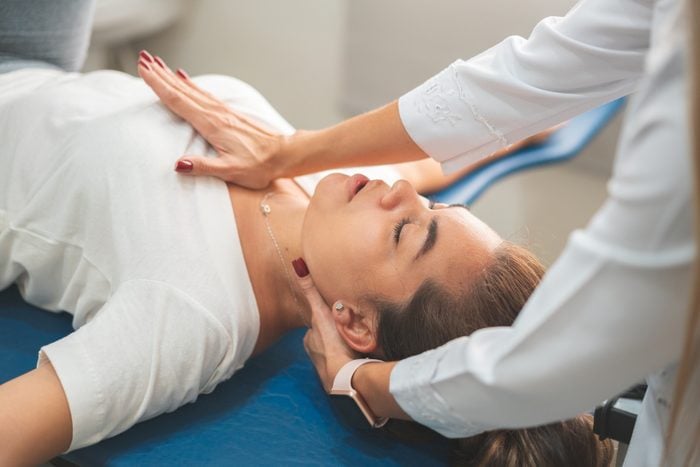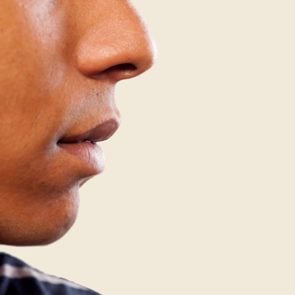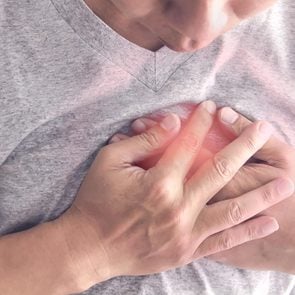Covid-19 Breathing Exercises for Recovery (and Prevention): Respiratory Therapists’ Step-by-Step Process
Updated: Apr. 13, 2022

Some research has found that breathing exercises can be one of the most effective ways to help your lungs recover from Covid-19—as well as one possible way to stay in optimal health if you're trying to avoid infection.
Covid-19 is a respiratory infection that can significantly affect the lungs, so it’s only natural that some Covid patients are finding relief from breathing exercises as a therapeutic part of recovery. Bushra Mina, MD, section chief of pulmonary medicine at Lenox Hill Hospital in New York City, says Covid breathing exercises can improve endurance and lung function, and even combat the fatigue, that can all result from a Covid-19 infection.
But also, say some experts, proactively practicing some breathing exercises can be a meaningful way to stay well, whether you’d had Covid yet or not. “We want patients not just to take a deep breath every now and then, but to have a routine practice,” Dr. Mina says. Even if you haven’t had Covid, it’s possible the right breathing exercises can boost your immune system and increase your chances of staying healthy.
Research backs this up. One November 2021 published in the peer-reviewed journal, Clinical Rehabilitation, looked at the effects of breathing exercises and strength training over 14 days among 77 patients who’d had active Covid. Breathing exercises were were the more effective of the two approaches at improving fatigue and aerobic capacity (the ability to engage in cardiovascular activity).
14 Signs You May Have Already Had Covid-19, Doctors Reveal
Covid breathing exercises—who should do them?
The type of Covid breathing exercises you do depends on how severe your infection is (or was) and where you are in your convalescence. “It’s very individualized,” says Dr. Mina. “It depends if you’re walking around, lying in a bed or sitting in a chair, as well as your body mass index, neurological deficits, and more.”
Someone who is still bedridden with symptoms likely needs guidance from a pulmonologist or respiratory therapist. People with ongoing symptoms from “long Covid” are usually referred to pulmonary rehabilitation, where they work with specialized therapists, says Carl Hinkson, a respiratory therapist and president-elect of the American Association for Respiratory Care.
“Not all SARS-Cov-2 [the virus that causes Covid] infections are created equal,” adds Talia Pollok, DPT, a critical and acute care physical therapist and board-certified clinical specialist in cardiovascular and pulmonary physical therapy in Charlottesville, VA. “But any type of breathing exercise or breathing pattern retraining is generally safe for anyone to do at home.”
That said, especially if you’ve had Covid, it’s important to assess any lung damage and consult a respiratory therapist to pick the exercises that are best suited for you while you’re recovering at home, says William Checkley, MD, PhD, associate professor of medicine in the division of pulmonary critical care at Johns Hopkins Medicine in Baltimore.
Diaphragmatic breathing
One type of breathing exercise stands out as particularly helpful: diaphragmatic breathing, or deep breathing from your diaphragm in the abdominal region. The lungs don’t have any innate muscles to help with the movement of air in and out, explains Dr. Checkley. Instead they rely on the diaphragm, which is the muscle right below your lungs.
Think of deep breathing as training your diaphragm muscle—which, after all, is a muscle many of us don’t actively train, says Hinkson, who is also director of the pulmonary service line at Providence Regional Medical Center in Everett, WA. “You’re training the muscle to be bigger, like doing curls for your bicep,” he adds.
Diaphragmatic breathing also aids the accessory muscles, which help expand the rib cage, Dr. Checkley explains.
Also importantly, this deep belly breathing signals your brain to calm you down. “When they’re stressed or anxious or have some modicum of lung disease, most people have breathing patterns that are more in the upper chest and out through the mouth,” explains Pollok. It’s part of the fight or flight response, and breathing from your abdomen helps pull you out of the reaction.
How does diaphragmatic breathing work?
This type of Covid breathing exercise is actually pretty simple to do, but it can take practice.
Step 1. Start by lying flat on your back with your head elevated and your knees supported. Put one hand on your stomach and the other on your chest. Breathe deeply through your nose. “The nose acts as a filtration and humidification device,” explains Pollok. “Your nose has small fine hairs and cilia that will trap any small particles like seasonal allergens. With the humidification, it allows the air to move into your lungs and disperse in a more efficient way.”
Step 2. Exhale through your mouth. That exhale should take two or three times as long as the inhale, says the American Lung Association. The hand on your stomach should rise and fall as your diaphragm expands and contracts with each breath. The hand on your chest should stay relatively still.
Step 3. From lying down, you can progress to doing this exercise sitting up, then standing up—then incorporating it into movement, says Dr. Checkley. In other words, start slow and ramp up gradually.
Should I use a spirometer?
One study found that patients who practiced deep breathing with a spirometer increased oxygen levels in their blood and had shorter hospital stays compared to those who received usual care.
A spirometer (also called an incentive spirometer) measures how much air goes in and out. They’re widely available, but your doctor may give you one to take home if you’ve been in the hospital with Covid. “It’s really a visible reminder of taking deep breaths and something for your eyes to focus on,” says Jean Lee, RRT, CPFT, a respiratory therapist and pulmonary function technician at Penn Highlands DuBois in DuBois, PA. “It helps with goals.”
Here’s why it’s a good idea for most people to get the Covid-19 vaccine
Pursed-lip and other breathing exercises
Pursed-lip breathing is often used with people with chronic lung conditions, like emphysema, who are trying to control shortness of breath. You breathe in through your nose as you would with belly breathing, then purse your lips together and blow your breath out through your mouth. “It helps create some positive back-pressure and expels air from your lungs more easily,” says Pollok.
Humming while you exhale may help dilate the sinuses, making it easier for oxygen from air to circulate through your body.
Make sure you know these common symptoms of Covid
Can breathing exercises prevent a Covid-19 infection?
There’s no evidence that breathing exercises per se can prevent Covid-19 infection, but they can improve your lung and all-around health during the Covid-19 pandemic.
Another help for staying well? Regular aerobic exercise will strengthen your immune system and lower your risk of getting sick in general, says Dr. Mina. That includes people with Covid-19 infections, according to a 2020 review in Diabetes & Metabolic Syndrome: Clinical Research & Reviews.
This could be as simple as taking a walk, pedaling on a stationary bike or climbing a flight of steps, Dr. Mina suggests.
How to Exercise After Covid-19: Lung and Exercise Science Doctors Share Current Wisdom
When to call your healthcare provider
If you know you have Covid, suspect you have Covid or if you’ve recently been exposed, Dr. Mina recommends getting in touch with a doctor, especially if you’re in a high-risk Covid-19 category (over the age of 65 or with a chronic medical condition). “Even if you have mild symptoms, your clinical status can change quickly,” he adds.
It’s also a good idea to check with an expert about how often to do breathing exercises, especially if you’re just beginning recovery.
If you haven’t been infected and just want to maintain optimal health, “diaphragmatic breathing five minutes in the morning before you get out of bed, and in the evening before you go to bed, can help your nervous system calm down,” says Pollok. “It’s a great way to start the day.”
Sign up for The Healthy @Reader’s Digest newsletter for daily tips on total wellness. Follow us on Facebook and Instagram, and keep reading:



